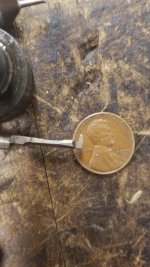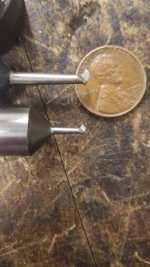implmex
Diamond
- Joined
- Jun 23, 2002
- Location
- Vancouver BC Canada
Good morning gentlemen:
I have a threading question for the lathe using the two line version of G76. (Fanuc OI)
Here's the problem:
Small diameter internal thread quite deep so skinny solid carbide bar.
Root dia is 0.104"
Depth is 0.460"
Material is 360 brass (thank God!!)
Tool tip flat is 0.001" (almost dead sharp)
60 degree vee.
Two profiles to cut:
The first is as pointy at the OD as I can make it (that's why such a pointy tool)
The second has an 0.006" flat at the OD.
I can make the pointy profile with lots of tiny passes and lots of spring passes and it comes out within tolerance when I section it using the wire EDM and check it on the shadowgraph.
If I put a flat on the tool tip for the second profile the tool springs too much to cut well.
So, I've programmed it in multiple G76 lines each with a 0.0005" offset in the Zstart position but with all of the passes for each G76 line so it cuts a LOT of air.
Here's my question:
Can I increase the first pass DOC safely on all the G76 lines after the first one without losing my registration of the tool to the developing thread?
We know that when the included angle is set to 60 in the first G76 line it will calculate a new Zstart for every pass as it works it's way down the trailing flank, starting from the first pass.
If I put in a big first pass DOC does it still make the same calculation, in other words would my tool tip end up in the same place when the thread is to depth regardless whether I cut it in 2 passes or 10 passes?
Another way to ask I suppose is to ask if I cut the thread in multiple passes using a single instance of G76 and one start position; then do a completely separate pass using a separate G76 line with the same Zstart position but coding for only one pass at full depth, will I trash the thread on the second pass from mis-registration of the tool in Z.
I know this is clear as mud, hopefully one of you understands what I'm asking and can advise me with confidence.
I don't want to just try it because I don't think the tool will survive if it doesn't work, but this threading is taking forever and I have 10 parts to cut.
Cheers
Marcus
Implant Mechanix • Design & Innovation > HOME
www.vancouverwireedm.com
I have a threading question for the lathe using the two line version of G76. (Fanuc OI)
Here's the problem:
Small diameter internal thread quite deep so skinny solid carbide bar.
Root dia is 0.104"
Depth is 0.460"
Material is 360 brass (thank God!!)
Tool tip flat is 0.001" (almost dead sharp)
60 degree vee.
Two profiles to cut:
The first is as pointy at the OD as I can make it (that's why such a pointy tool)
The second has an 0.006" flat at the OD.
I can make the pointy profile with lots of tiny passes and lots of spring passes and it comes out within tolerance when I section it using the wire EDM and check it on the shadowgraph.
If I put a flat on the tool tip for the second profile the tool springs too much to cut well.
So, I've programmed it in multiple G76 lines each with a 0.0005" offset in the Zstart position but with all of the passes for each G76 line so it cuts a LOT of air.
Here's my question:
Can I increase the first pass DOC safely on all the G76 lines after the first one without losing my registration of the tool to the developing thread?
We know that when the included angle is set to 60 in the first G76 line it will calculate a new Zstart for every pass as it works it's way down the trailing flank, starting from the first pass.
If I put in a big first pass DOC does it still make the same calculation, in other words would my tool tip end up in the same place when the thread is to depth regardless whether I cut it in 2 passes or 10 passes?
Another way to ask I suppose is to ask if I cut the thread in multiple passes using a single instance of G76 and one start position; then do a completely separate pass using a separate G76 line with the same Zstart position but coding for only one pass at full depth, will I trash the thread on the second pass from mis-registration of the tool in Z.
I know this is clear as mud, hopefully one of you understands what I'm asking and can advise me with confidence.
I don't want to just try it because I don't think the tool will survive if it doesn't work, but this threading is taking forever and I have 10 parts to cut.
Cheers
Marcus
Implant Mechanix • Design & Innovation > HOME
www.vancouverwireedm.com





